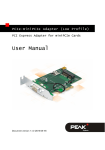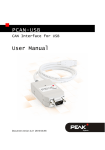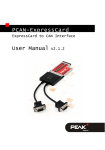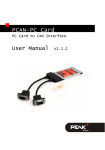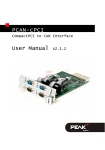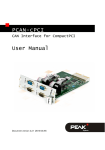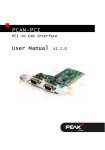Download PCAN-miniPCIe - User Manual - Home: PEAK-System PCAN
Transcript
PCAN-miniPCIe CAN Interface for PCI Express Mini User Manual Document version 1.2.1 (2014-04-30) PCAN-miniPCIe – User Manual Products taken into account Product Name Model Part number PCAN-miniPCIe Single Channel One CAN channel, galvanic isolation for CAN connection IPEH-003048 PCAN-miniPCIe Dual Channel Two CAN channels, galvanic isolation for CAN connections IPEH-003049 The cover picture shows the product PCAN-miniPCIe Dual Channel. The Single Channel model has an identical form factor but varies in equipment. CANopen® and CiA® are registered community trade marks of CAN in Automation e.V. All other product names mentioned in this document may be the trademarks or registered trademarks of their respective companies. They are not explicitly marked by “™” or “®”. © 2014 PEAK-System Technik GmbH PEAK-System Technik GmbH Otto-Roehm-Strasse 69 64293 Darmstadt Germany Phone: +49 (0)6151 8173-20 Fax: +49 (0)6151 8173-29 www.peak-system.com [email protected] Document version 1.2.1 (2014-04-30) 2 PCAN-miniPCIe – User Manual Contents 1 1.1 1.2 1.3 Introduction 4 Properties at a Glance System Requirements Scope of Supply 4 5 5 2 Installing the Software and the Card 6 3 Connecting the CAN Bus 9 3.1 D-Sub Connector 3.2 Cabling 3.2.1 Termination 3.2.2 Example of a Connection 3.2.3 Maximum Bus Length 9 11 11 11 12 4 13 Using the Software 4.1 CAN Monitor PCAN-View for Windows 4.1.1 Receive/Transmit Tab 4.1.2 Trace Tab 4.1.3 Status Bar 4.2 Linking Own Programs with PCAN-Basic 4.2.1 Features of PCAN-Basic 4.2.2 Principle Description of the API 4.2.3 Notes about the License 13 15 17 18 19 20 21 22 5 23 Technical Specifications Appendix A CE Certificate 25 Appendix B Dimension Drawing 26 Appendix C Quick Reference 27 3 PCAN-miniPCIe – User Manual 1 Introduction The PCAN-miniPCIe card enables the connection of embedded PCs and laptops with PCI Express Mini slots to CAN networks. There is galvanic isolation of up to 300 Volts between the computer and CAN sides. Device drivers and a programming interface exist for different operating systems, so programs can easily access a connected CAN bus. Tip: At the end of this manual (Appendix C) you can find a Quick Reference with brief information about the installation and operation of the PCAN-miniPCIe card. 1.1 Properties at a Glance CAN interface for the PCI Express Mini slot CAN bus connection via connection cable and D-Sub, 9-pin (in accordance with CiA® 102) Bit rates from 5 kbit/s up to 1 Mbit/s Compliant with CAN specifications 2.0A (11-bit ID) and 2.0B (29-bit ID) CAN controller FPGA implementation (SJA1000 compatible) NXP PCA82C251 CAN transceiver Galvanic isolation on the CAN connection up to 300 V, separate for each CAN channel Space-saving dimensions thanks to SMD technology Extended operating temperature range of -40 to 85 °C (-40 to 185 °F) Single-channel or dual-channel model 4 PCAN-miniPCIe – User Manual Note: This manual describes the use of the PCAN-miniPCIe card with Windows. You can find device drivers for Linux and the corresponding application information on the provided DVD in the Develop directory branch and on our website under www.peak-system.com/linux. 1.2 System Requirements A vacant PCI Express Mini slot in the computer Operating system Windows 8, 7, Vista (32/64-bit) or Linux (32/64-bit) 1.3 Scope of Supply PCAN-miniPCIe card Connection cable including D-Sub plug for each channel Device drivers for Windows 8, 7, Vista and Linux (32/64-bit) PCAN-View CAN monitor for Windows 8, 7, Vista (32/64-bit) PCAN-Basic programming interface consisting of an interface DLL, examples, and header files for all common programming languages Manual in PDF format 5 PCAN-miniPCIe – User Manual 2 Installing the Software and the Card This chapter covers the software setup for the PCAN-miniPCIe card under Windows and the installation in the computer. Setup the driver before installing the PCAN-miniPCIe card for the first time. Do the following to install the driver and additional software: 1. Make sure that you are logged in as user with administrator privileges (not needed for normal use of the card later on). 2. Insert the supplied DVD into the appropriate drive of the computer. Usually a navigation program appears a few moments later. If not, start the file Intro.exe from the root directory of the DVD. 3. On the page English > Drivers activate the entry PCAN-PCI. 4. Click on Install now. The setup program for the driver is executed. 5. Follow the instructions of the setup program. Tip: If you do not want to install the CAN monitor PCAN-View for Windows onto the hard disk together with the driver, you have the option to start the program later directly from DVD without prior installation. Do the following to install the card into the computer: Attention! Electrostatic discharge (ESD) can damage or destroy components on the PCAN-miniPCIe card. Take precautions to avoid ESD when handling the card. 1. Shut down the computer. 6 PCAN-miniPCIe – User Manual 2. Disconnect the computer from the power supply. 3. Open the computer's casing. 4. Insert the PCAN-miniPCIe card into an empty PCI Express Mini slot. For details refer to the documentation of the computer. 5. For each CAN channel, mount a D-Sub connector with connection circuit board into a respective hole of the computer casing. 6. For each CAN channel interconnect a D-Sub connector and the corresponding port on the PCAN-miniPCIe card. CAN 1 CAN 2 Figure 1: Positions of the CAN ports on the PCAN-miniPCIe card 7. Close the computer's casing. 8. Reconnect the power supply of the computer. 7 PCAN-miniPCIe – User Manual Do the following to complete the initialization: 1. Turn on the computer and start Windows. Make sure that you are logged in as user with administrator privileges. Windows notifies that new hardware has been detected. 2. The drivers are found and installed by Windows. 3. Afterwards you can work as user with restricted rights again. After the driver has been successfully set up you can find the “PCAN-miniPCIe” entry in the “CAN-Hardware” branch of the Windows Device Manager. 8 PCAN-miniPCIe – User Manual 3 3.1 Connecting the CAN Bus D-Sub Connector A High-speed CAN bus (ISO 11898-2) is connected to a 9-pin D-Sub connector. The pin assignment for CAN corresponds to the specification CiA® 102. Figure 2: Pin assignment High-speed CAN (view onto a D-Sub connector) Figure 3: PCAN-miniPCIe card with connection cables 9 PCAN-miniPCIe – User Manual To connect a CAN bus to the PCAN-miniPCIe card, use the supplied special connection cables. After you've plugged in the cable on the PCAN-miniPCIe card, you can connect a CAN bus to the D-sub socket. The pin assignment between the D-Sub port and the 4-pin connector 1 on the PCAN-miniPCIe card is as follows: Figure 4: Front view of a CAN connector (SUR) on the PCAN-miniPCIe card (CAN 1, CAN 2) Pin SUR 1 Function Pin D-Sub 1 Not used 1 2 GND 3, 6 3 CAN_H 7 4 CAN_L 2 Connector type SUR from JST (www.jst-mfg.com), name of the matching plug: 04SUR-32S 10 PCAN-miniPCIe – User Manual 3.2 3.2.1 Cabling Termination A High-speed CAN bus (ISO 11898-2) must be terminated on both ends with 120 Ohms. Otherwise, there are interfering signal reflections and the transceivers of the connected CAN nodes (CAN interface, control unit) do not work. The PCAN-miniPCIe card does not have an internal termination. Use the adapter on a terminated CAN bus. 3.2.2 Example of a Connection Figure 5: Simple CAN connection In this example, the PCAN-miniPCIe card is connected with a control unit by a cable that is terminated at both ends. 11 PCAN-miniPCIe – User Manual 3.2.3 Maximum Bus Length High-speed CAN networks may have bit rates of up to 1 Mbit/s. The maximum bus length is primarily depending on the bit rate. The following table shows the maximum CAN bus length at different bit rates: Bit rate Bus length 1 Mbit/s 40 m 500 kbit/s 110 m 250 kbit/s 240 m 125 kbit/s 500 m 50 kbit/s 1.3 km 20 kbit/s 3.3 km 10 kbit/s 6.6 km 5 kbit/s 13.0 km The listed values have been calculated on the basis of an idealized system and can differ from reality. 12 PCAN-miniPCIe – User Manual 4 Using the Software This chapter covers the provided software PCAN-View and the programming interface PCAN-Basic. 4.1 CAN Monitor PCAN-View for Windows PCAN-View for Windows is a simple CAN monitor for viewing, transmitting, and logging CAN messages. Figure 6: PCAN-View for Windows Do the following to start and initialize PCAN-View: 1. If PCAN-View is already installed on the hard disk, open the Windows Start menu, go to Programs > PCAN-Hardware, and select the entry PCAN-View. 13 PCAN-miniPCIe – User Manual If you haven't installed PCAN-View together with the device driver, you can start the program directly from the supplied DVD. In the DVD navigation program (Intro.exe), go to English > Tools, and under PCAN-View for Windows select the Start link. The dialog box for selecting the CAN hardware and for setting the CAN parameters appears. Figure 7: Selection of the CAN specific hardware and parameters 2. From the list Available CAN hardware select the CAN channel to be used. 3. Select the Bit rate that is used by all nodes on the CAN bus. 4. Under Filter settings you can limit the range of CAN IDs to be received, either for standard frames (11-bit IDs) or for extended frames (29-bit IDs). 5. Finally confirm the settings in the dialog box with OK. The main window of PCAN-View appears (see Figure 8). 14 PCAN-miniPCIe – User Manual 4.1.1 Receive/Transmit Tab Figure 8: Receive/Transmit tab The Receive/Transmit tab is the main element of PCAN-View. It contains two lists, one for received messages and one for the transmit messages. Representation of CAN data is in hexadecimal format. Do the following to transmit a CAN message with PCAN-View: 1. Select the menu command Transmit > New Message (alternatively or Ins). The dialog box New Transmit Message is shown. 15 PCAN-miniPCIe – User Manual Figure 9: Dialog box New transmit message 2. Enter the ID and the data for the new CAN message. 3. The Cycle Time field indicates if the message will be transmitted manually or periodically. If you want to transmit the message periodically, you must enter a value greater than 0. For a manual-only transmission enter 0. 4. Confirm the entries with OK. The created transmit message appears on the Receive/Transmit tab. 5. You trigger selected transmit messages manually with the menu command Transmit > Send (alternatively Space bar). The manual transmission for CAN messages being transmitted periodically is carried out additionally. Tip: Using the menu command File > Save, you can save the current transmit messages to a list and reload them later on. 16 PCAN-miniPCIe – User Manual 4.1.2 Trace Tab Figure 10: Trace tab On the Trace tab the data tracer of PCAN-View is used for logging the communication on a CAN bus. During this process the CAN messages are cached in the working memory of the PC. Afterwards they can be saved to a file. The tracer can be configured to run in linear or in ring buffer mode. In linear buffer mode the logging is stopped as soon as the buffer is filled completely. In ring buffer mode the oldest messages are overwritten by incoming ones. 17 PCAN-miniPCIe – User Manual 4.1.3 Status Bar Figure 11: Example of the status bar The status bar shows information about the current CAN connection, about error counters (Overruns, QXmtFull), and error messages. You can find further information about the use of PCAN-View in the help which you can invoke in the program via the Help menu or with the F1 key. 18 PCAN-miniPCIe – User Manual 4.2 Linking Own Programs with PCAN-Basic Figure 12: PCAN-Basic On the provided DVD you can find files of the programming interface PCAN-Basic in the Develop directory branch. This API provides basic functions for linking own programs to CAN interfaces by PEAK-System and can be used for the following operating systems: Windows 8, 7, Vista (32/64-bit) Windows CE 6.x (x86/ARMv4) Linux (32/64-bit) The API is designed for cross-platform use. Therefore, software projects can easily ported between platforms with low efforts. PEAKSystem has created examples for the following programming languages: C++, C#, C++/CLR, Visual Basic, Delphi, Python, and Java. 19 PCAN-miniPCIe – User Manual 4.2.1 Features of PCAN-Basic Supports Windows 8, 7, Vista (32/64-bit), Windows CE 6.x, and Linux (32/64-bit) operating systems Multiple PEAK-System applications and your own can be operated on a physical CAN channel at the same time Use of a single DLL for all supported hardware types Use of up to 8 channels for each hardware unit (depending on the PEAK CAN interface used) Simple switching between channels of a PEAK CAN interface Driver-internal buffer for 32768 messages per CAN channel Precision of time stamps on received messages up to 1 μs (depending on the PEAK CAN interface used) Access to specific hardware parameters, such as listen-only mode Notification of the application through Windows events when a message is received Extended system for debugging operations Multilingual debugging output Output language depends on operating system Debugging information can be defined individually An overview of the API functions is located in the header files. You can find detailed information about the PCAN-Basic API on the provided DVD in the text and help files (file name extensions .txt and .chm). 20 PCAN-miniPCIe – User Manual 4.2.2 Principle Description of the API The PCAN-Basic API is the interface between the user application and device driver. In Windows operating systems this is a DLL (Dynamic Link Library). The sequence of accessing the CAN interface is divided into three phases: 1. Initialization 2. Interaction 3. Completion Initialization A CAN channel must be initialized before using it. This is done by the simple call of the function CAN_Initialize. Depending on the type of the CAN hardware, up to eight CAN channels can be opened at the same time. After a successful initialization the CAN channel is ready for communication with the CAN hardware and the CAN bus. No further configuration steps are required. Interaction For receiving and transmitting CAN messages the functions CAN_Read and CAN_Write are available. Additional settings can be made, e.g. setting up message filters to confine to specific CAN IDs or setting the CAN controller to listen-only mode. When receiving CAN messages, events are used for an automatic notification of an application (client). This offers the following advantages: The application no longer needs to check for received messages periodically (no polling). The response time at reception is reduced. 21 PCAN-miniPCIe – User Manual Completion To end the communication the function CAN_Uninitialize is called in order to release the reserved resources for the CAN channel, among others. In addition the CAN channel is marked as "Free" and is available to other applications. 4.2.3 Notes about the License Device drivers, the interface DLL, and further files needed for linking are property of the PEAK-System Technik GmbH and may be used only in connection with a hardware component purchased from PEAK-System or one of its partners. If a CAN hardware component of third-party suppliers should be compatible to one of PEAKSystem, then you are not allowed to use or to pass on the driver software of PEAK-System. If a third-party supplier develops software based on the PCAN-Basic and problems occur during the use of this software, consult the software provider. 22 PCAN-miniPCIe – User Manual 5 Technical Specifications Connectors Computer PCI Express Mini slot, 52-pin; electromechanical specifications 1.1 and 1.2 CAN (via cable) D-Sub (m), 9-pin, assignment according to specification CiA® 102 CAN (on card) Connector type SUR from JST (www.jst-mfg.com), name of the matching plug: 04SUR-32S CAN Specification ISO 11898-2, High-speed CAN 2.0A (Standard format) and 2.0B (Extended format) Bit rates 5 kbit/s - 1 Mbit/s Controller FPGA implementation (SJA1000 compatible) Transceiver NXP PCA82C251 Galvanic isolation up to 300 V (separate for each CAN connector) Termination none Power supply Supply voltage 1.5 V and 3.3 V Current consumption 1.5 V: max. 180 mA 3.3 V: max. 330 mA Measures Size 30 x 51 x 4 mm (W x L x H) See also dimension drawing in Appendix B on page 26. Weight Card: max. 7 g Cable + D-Sub: max. 16 g Length connection cable (card - D-Sub) 20 cm, other cable lengths on request Continued on the next page 23 PCAN-miniPCIe – User Manual Environment Operating temperature -40 - 85 °C (-40 - 185 °F) Temperature for storage and transport -40 - 100 °C (-40 - 212 °F) Relative humidity 15 - 90 %, not condensing EMC EN 55024:2011-09 EN 55022:2011-12 EC directive 2004/108/EG 24 PCAN-miniPCIe – User Manual Appendix A CE Certificate 25 PCAN-miniPCIe – User Manual Appendix B Dimension Drawing Figure 13: View PCAN-miniPCIe The figure does not show the actual size of the product. 26 PCAN-miniPCIe – User Manual Appendix C Quick Reference Software/Hardware Installation under Windows Before installing the PCAN-miniPCIe card into the computer please set up the corresponding software package from the supplied DVD (with administrator privileges). Afterwards, insert the PCANminiPCIe card into a vacant PCI Express Mini slot of the switched off (de-energized) computer. At the next start of Windows the PCANminiPCIe card is recognized by Windows and the driver is initialized. After the driver has been successfully installed, you can find the “PCAN-miniPCIe” entry in the “CAN-Hardware” branch of the Windows Device Manager. Getting Started under Windows Run the CAN monitor PCAN-View from the Windows Start menu as a sample application for accessing the PCAN-miniPCIe card. For initialization of the PCAN-miniPCIe card, select the CAN connection and the CAN bit rate. High-speed CAN connector (D-Sub, 9 pins) 27




























